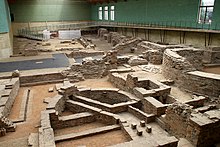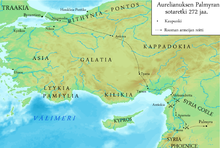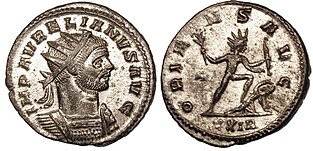Aurelian
| Aurelian | |
|---|---|
Henotheist of Sol Invictus |
Aurelian (
During his reign, he defeated the
Although Domitian, two centuries earlier, was the first emperor who had demanded to be officially hailed as dominus et deus ("master and god"), these titles never occurred in written form on official documents until the reign of Aurelian.[4] His successes were instrumental in ending the crisis, earning him the title Restitutor Orbis ("Restorer of the World").
Early life
Many details about Aurelian's early life come from the Historia Augusta and are considered unreliable. Comparative research with other sources from his era has rendered some details more secure than others. Aurelian was born on 9 September, a date recorded in the Chronograph of 354.[5] The 6th-century chronicler John Malalas wrote that he died at the age of 61, implying a birth in 214.[6] However, his chronicle is often described as "too frequently unreliable",[7] meaning that his statement may not be completely accurate.
The Historia Augusta describes him both as a Pannonian from
Military service
It is commonly accepted that Aurelian probably joined the army in 235 at around age twenty.
Whatever his origins, Aurelian certainly must have built up a very solid reputation for military competence during the tumultuous mid-decades of the century. To be sure, the exploits detailed in the
Ulpius Crinitus
The existence of Ulpius Crinitus has been doubted by many
Under Gallienus
Aurelian's successes as a cavalry commander ultimately made him a member of Emperor
Aurelian was married to
Under Claudius
Claudius was proclaimed emperor by the soldiers outside Mediolanum. The new emperor immediately ordered the Senate to deify Gallienus. Next, Claudius began to distance himself from those responsible for his predecessor's assassination, ordering the execution of those directly involved.[26] Aureolus was still besieged in Mediolanum and sought reconciliation with the new emperor, but Claudius had no sympathy for a potential rival. The emperor had Aureolus killed and one source implicates Aurelian in the deed, perhaps even signing the warrant for his death himself.[26]
During the reign of Claudius, Aurelian was promoted rapidly: he was given command of the elite Dalmatian cavalry and soon promoted to overall head of the army after the emperor and what had been Emperor Claudius' own position before his acclamation.
While still dealing with the defeated enemy, news came from the
Claudius could not afford another pitched battle, so he instead laid a successful ambush, killing thousands. However, the majority of the Goths escaped and began retreating south the way they had come. For the rest of year, Aurelian harassed the enemy with his Dalmatian cavalry.[29]

Now stranded in Roman territory, the Goths' lack of provisions began to take its toll. Aurelian, sensing his enemies' desperation, attacked them with the full force of his cavalry, killing many and driving the remainder westward into Thrace.[29] As winter set in, the Goths retreated into the Haemus Mountains, only to find themselves trapped and surrounded. The harsh conditions now exacerbated their shortage of food. However, the Romans underestimated the Goths and let their guard down, allowing the enemy to break through their lines and escape. Apparently emperor Claudius ignored advice, perhaps from Aurelian, and withheld the cavalry and sent in only the infantry to stop their break-out.
The determined Goths killed many of the oncoming infantry and were only prevented from slaughtering them all when Aurelian finally charged in with his Dalmatian cavalry. The Goths still managed to escape and continued their march through Thrace.[29] The Roman army continued to follow the Goths during the spring and summer of 270. Meanwhile, a devastating plague swept through the Balkans, killing many soldiers in both armies.
Emperor Claudius fell ill on the march to the battle and returned to his regional headquarters in Sirmium, leaving Aurelian in charge of operations against the Goths.[29] Aurelian used his cavalry to great effect, breaking the Goths into smaller groups which were easier to handle. By late summer the Goths were defeated: any survivors were stripped of their animals and booty and were levied into the army or settled as farmers in frontier regions.[29] Aurelian had no time to relish his victories; in late August news arrived from Sirmium that emperor Claudius was dead.[30]
Emperor
This section needs additional citations for verification. (March 2021) |
Rise to power
When Claudius died, his brother Quintillus seized power with support of the Senate. With an act typical of the Crisis of the Third Century, the army refused to recognize the new emperor, preferring to support one of its own commanders: Aurelian was proclaimed emperor about August or September[31][32] (older sources argue for May)[33] by the legions in Sirmium. Aurelian defeated Quintillus' troops, and was recognized as emperor by the Senate after Quintillus' death. The claim that Aurelian was chosen by Claudius on his death bed[34] can be dismissed as propaganda; later, probably in 272, Aurelian put his own dies imperii at the day of Claudius' death, thus implicitly considering Quintillus a usurper.[35]
With his base of power secure, he now turned his attention to Rome's greatest problems – recovering the vast territories lost over the previous two decades, and reforming the res publica.
The Roman Empire in the 270s

In 248, Emperor Philip the Arab had celebrated the millennium of the city of Rome with great and expensive ceremonies and games, and the Empire had given a tremendous proof of self-confidence.[36] In the following years, however, the Empire had to face a huge pressure from external enemies, while, at the same time, dangerous civil wars threatened the empire from within, with usurpers weakening the strength of the state. Also, the economic substrate of the state, agriculture and commerce, suffered from the disruption caused by the instability. On top of this an epidemic swept through the Empire around 250, greatly diminishing manpower[37] both for the army and for agriculture.
The end result was that the Empire could not endure the blow of the capture of Emperor
In Rome, the Emperor was occupied with internal menaces to his power and with the defence of
Reunification of the empire
The first actions of the new Emperor were aimed at strengthening his own position in his territories. Late in 270, Aurelian campaigned in northern
Defending Italy against the Juthungi

The burden of the northern barbarians was not yet over, however. In 271, the
Defeat of the Goths and abandonment of Dacia
The emperor led his legions to the Balkans, where he defeated and routed the Goths beyond the Danube, killing the Gothic leader
Conquest of the Palmyrene Empire


In 272, Aurelian turned his attention to the lost eastern provinces of the empire, the
Asia Minor was recovered easily; every city but

Eventually Zenobia and her son were captured and made to walk the streets of Rome in his triumph, the woman in golden chains. With the grain stores once again shipped to Rome, Aurelian's soldiers handed out free bread to the citizens of the city, and the Emperor was hailed a hero by his subjects. After a brief clash with the Persians and another in Egypt against the usurper Firmus, Aurelian was obliged to return to Palmyra in 273 when that city rebelled once more. This time, Aurelian allowed his soldiers to sack the city, and Palmyra never recovered. More honors came his way; he was now known as Parthicus Maximus and Restitutor Orientis ("Restorer of the East").[35]
The rich province of Egypt was also recovered by Aurelian. The Brucheion (Royal Quarter) in Alexandria was burned to the ground. This section of the city once contained the Library of Alexandria, although the extent of the surviving Library in Aurelian's time is uncertain.
Conquest of the Gallic Empire
In 274, the victorious emperor turned his attention to the west, and the


Aurelian returned to Rome and won his last honorific from the Senate – Restitutor Orbis ("Restorer of the World"). This title was first assumed by Aurelian in late summer of 272, and had been carried previously by both Valerian and Gallienus.[24] In four years, Aurelian had secured the frontiers of the Empire and reunified it.[citation needed]
Reforms
Aurelian was a reformer, and settled many important functions of the imperial apparatus, dealing with the economy and religion. He restored many public buildings, reorganized the management of the food reserves, set fixed prices for the most important goods, and prosecuted misconduct by the public officers.[45]
Religious reform
Aurelian strengthened the position of the Sun god Sol Invictus as the main divinity of the Roman pantheon. His intention was to give to all the peoples of the Empire, civilian or soldiers, easterners or westerners, a single god they could believe in without betraying their own gods. The centre of the cult was a new temple, built in 274 and dedicated on December 25[46] of that year in the Campus Agrippae in Rome, with great decorations financed by the spoils of the Palmyrene Empire.
During his short rule, Aurelian seemed to follow the principle of "one faith, one empire", which would not be made official until the Edict of Thessalonica. He appears with the title deus et dominus natus ("God and born ruler") on some of his coins, a style also later adopted by Diocletian. Lactantius argued that Aurelian would have outlawed all the other gods if he had had enough time. He was recorded by Christian historians as having organized persecutions.[47][48][49][50]
Felicissimus' rebellion and coinage reform
Aurelian's reign records the only uprising of mint workers. The rationalis Felicissimus, a senior public financial official whose responsibilities included supervision of the mint at Rome, revolted against Aurelian. The revolt seems to have been caused by the fact that the mint workers, and Felicissimus first, were accustomed to stealing the silver for the coins and producing coins of inferior quality. Aurelian wanted to eliminate this, and put Felicissimus on trial. The rationalis incited the mint workers to revolt: the rebellion spread in the streets, even if it seems that Felicissimus was killed immediately, presumably executed.
The Palmyrene rebellion in Egypt had probably reduced the
Aurelian ordered the
His monetary reformation included the introduction of antoniniani containing 5% silver. They bore the mark XXI (or its Greek numeral form KA), which meant that twenty of such coins would contain the same silver quantity of an old silver denarius.[52][e] Considering that this was an improvement over the previous situation gives an idea of the severity of the economic situation Aurelian faced. The Emperor struggled to introduce the new "good" coin by recalling all the old "bad" coins before their introduction.[35]
A very large number of rare gold coins of Aurelian have been discovered as part of the Lava Treasure in Corsica, France, in the 1980s.[53]
Food distribution reforms
Rome had been distributing grain to its poorest citizens at a reduced price since 123 BC, and for free since 58 BC through the
Aurelian is believed to have terminated Trajan's alimenta program. Roman prefect Titus Flavius Postumius Quietus was the last known official in charge of the alimenta, in 271. If Aurelian "did suppress this food distribution system, he most likely intended to put into effect a more radical reform." Indeed, around this time, Aurelian reformed the Cura Annonae to replace the dole of grain by a dole of bread, salt and pork, as well as subsidized prices for other goods such as oil and wine.[55]
Death

The deaths of the Sassanid Kings
However, Aurelian never reached Persia, as he was murdered while waiting in Thrace to cross into Asia Minor. As an administrator, he had been strict and had handed out severe punishments to corrupt officials or soldiers. A secretary of his (called Eros by
Aurelian's enemies in the Senate briefly succeeded in passing damnatio memoriae on the emperor, but this was reversed before the end of the year, and Aurelian, like his predecessor Claudius II, was deified as Divus Aurelianus.
There is some evidence that Aurelian's wife,
Legacy
The city of Orléans in France is named after Aurelian. Originally named Cenabum, Aurelian rebuilt and renamed it Aurelianum or Aureliana Civitas ("city of Aurelian", cité d'Aurélien), which evolved into Orléans. The city of New Orleans (in French, La Nouvelle-Orléans, in Latin, Nova Aurelianum), in Louisiana, United States is named after the commune of Orléans, and therefore by extension, Aurelian.[58]
Notes
- ^ His full name, with honorific and victory titles, was Imperator Caesar Lucius Domitius Aurelianus pius felix invictus Augustus, pontifex maximus, Germanicus maximus, Gothicus maximus, Parthicus maximus, Carpicus maximus, tribunicia potestate VI, consul III, imperator, pater patriae, proconsul, restitutor orbis.[3]
- ^ Had Aurelian's family been enfranchised by virtue of the Constitutio Antoniniana (212) his nomen would have been "Aurelius".
- ^ The tres militia were: (i) prefecture of a cohort of auxiliary infantry; (ii) tribunate of a legionary cohort; and (iii) prefecture of an ala of auxiliary cavalry.
- ^ Compare the career of Pertinax who pursued the Tres Militia with those of Publius Aelius Aelianus, Lucius Aurelius Marcianus (both probably) and Traianus Mucianus (certainly) who rose e caliga, i.e. through the ranks.
- ^ Later emperors Tacitus and Carus would mint coins with the legends XI or IA, signalling a 10% of silver in the alloy.
References
- OCLC 25050500.
- ^ White 2015, p. 139.
- ^ Groag, col. 157.
- ^ Halsberghe, G.H. (1972). The Cult of Sol Invictus. Etudes préliminaires aux religions orientales dans l'Empire romain. Brill. p. 152. Retrieved 13 April 2018.
- ^ a b Watson 1999, p. 1.
- ^ John Malalas, Book 12, chapter 30.
- ISBN 978-90-04-34462-4.
- S2CID 244540886.
- ^ Syvänne 2020, pp. 29–30.
- ^ Saunders 1992, p. 107.
- ^ Saunders 1992, p. 109.
- ^ For instance, vita Divi Aureliani paras 5.5–6, 6.3–5, and 7.1–2. If he ever was a tribune of a legion as suggested in 7.1–2 it could not have been with Legio VII Gallicana as that unit never existed.
- ^ Saunders 1992, pp. 129–130.
- ^ a b c White (2015), p. [1] ???
- ISBN 978-1-5267-4522-4.
- ^ ISBN 978-900-417-438-2.
- ISBN 0-415-30187-4.
- ^ "ToposText". topostext.org. Retrieved 7 June 2020.
- ISBN 0-415-30187-4.
- ^ "LacusCurtius: Templum Solis (Platner & Ashby, 1929)". penelope.uchicago.edu. Retrieved 23 June 2020.
- ^ Aurelius Victor, xxxiii,21. Other sources do not cite Aurelian among those who conspired against Gallienus, though different sources have claimed that he was the one who called Gallienus out of his tent under a proposed "conspiracy" at the point Gallienus was stabbed.
- ^ Watson 1999, p. 41.
- ISBN 0-520-06983-8, p. 54
- ^ a b Watson 1999.
- ^ a b c Körner, Christian (23 December 2008). "Aurelian (A.D. 270–275)". De Imperatoribus Romanis: An Online Encyclopedia of Roman Rulers and Their Families. Archived from the original on 2 December 2010. Retrieved 6 January 2011.
- ^ a b c Watson 1999, p. 42.
- ^ a b Watson 1999, p. 43.
- ^ a b Watson 1999, p. 44.
- ^ a b c d e Watson 1999, p. 45.
- ^ Watson 1999, p. 46.
- ^ a b Peachin 1990, pp. 43–44.
- ^ Kienast 2017, p. 222.
- ^ Stein, pp. 46, 50.
- ^ Zonaras.
- ^ a b c d Korner.
- ^ Magh, David. Historia Augusta. Vol. II. Loeb Classical Library.
- ^ "Solving the Mystery of an Ancient Roman Plague". The Atlantic. November 2017.
- ^ Zosimus, 1,48f.; Eutropius; Dexippus, FGrH IIA 460 F7; Historia Augusta – Aurelianus xxi,1–3 and xviii,2.
- ^ Watson 1999, pp. 51–54, 217.
- ^ Watson 1999, pp. 54–55.
- ^ The war against the Palmyrene Empire is described in Zosimus, 1,50,1–1,61,1, and Historia Augusta, Aurelianus, 22–31.
- ISBN 0472083155.
- ISBN 978-0-300-13719-4.
- ISBN 978-0-679-42308-9.
- ^ a b Chisholm, Hugh, ed. (1911). . Encyclopædia Britannica. Vol. 2 (11th ed.). Cambridge University Press. pp. 923–924.
- ISBN 978-3-406-47288-6.
- ^ Lactantius, De Mortibus Persecutorum 6.
- ^ Eusebius, Historia Ecclesiastica 7.30.20
- ^ Jerome, Chronicon, 263rd Olympiad
- ^ Orosius, Historiarum, Book 7, Chapter 23
- ^ Watson 1999, pp. 52–53.
- ^ Watson 1999, p. 130.
- ISBN 9782717724929
- ^ Watson, Alaric (2004), Aurelian and the Third Century, London: Routledge, pp, 139-140
- ISBN 978-0-415-73807-1, page 181.
- ^ Watson 1999, pp. 104–105, 225.
- ^ Watson 1999, pp. 113–116.
- ISBN 978-2-7297-0554-1.
Primary sources
- Aurelius Victor Epitome de Caesaribus, xxxv "Epitome de Caesaribus" (4th century)
- Eutropius, Breviarium historiae Romanae, IX. 13–15 (4th century)
- Historia Augusta Aurelianus Life of Aurelian Part 1 Part 2 Part 3
- Zosimus, Historia Nova Translation of the Historia Nova (published in 1814), book 1, (5th–6th century)
- Joannes Zonaras, Compendium of History Compendium excerpt: Claudius to Diocletian 268–284 (12th century)
Secondary sources
- Groag, Edmund, "Domitius 36", Realencyclopädie der classischen Altertumswissenschaft, volume 9 (V.1), Metzlerscher Verlag (Stuttgart, 1903), columns 1347–1419.
- Kienast, D. (2017). Römische Kaisertabelle. Grundzüge einer römischen Kaiserchronologie. Darmstadt: Wissenschaftliche Buchgesellschaft. ISBN 9783534132898.
- Körner, Christian (20 July 2001). "Aurelian". De Imperatoribus Romanis. Archived from the original on 20 October 2006. Retrieved 4 November 2006. (Korner:2001)
- Saunders, Randall Titus (1992). A biography of the Emperor Aurelian (AD 270–275). Ann Arbor, Michigan: UMI Dissertation Services.
- Southern, Pat (2001). The Roman Empire from Severus to Constantine. Routledge. p. 125. ISBN 0-415-23944-3.
- Peachin, Michael (1990). Roman Imperial Titulature and Chronology, A.D. 235–284. Amsterdam: Gieben. ISBN 90-5063-034-0.
- S2CID 161464046.
- Syvänne, Ilkka (2020). Aurelian and Probus: The Soldier Emperors Who Saved Rome. Yorkshire: Pen and Sword Military. ISBN 978-1-5267-6750-9.
- Watson, Alaric (1999). Aurelian and the Third Century (PDF). The Classical World. Vol. 94. London: Routledge. pp. 284–286. S2CID 153920517. Archived from the original(PDF) on 18 February 2020.
Further reading
- White, John (2015). The Roman Emperor Aurelian: Restorer of the World. Casemate Publishers and Book Distributors. ISBN 978-1-4738-4569-5.
